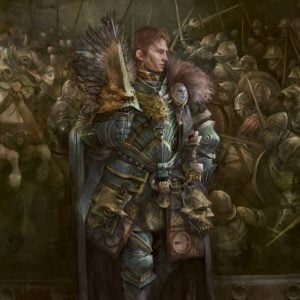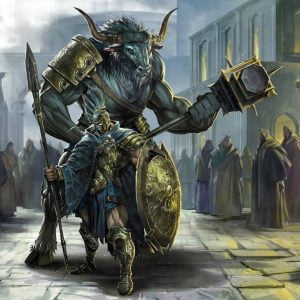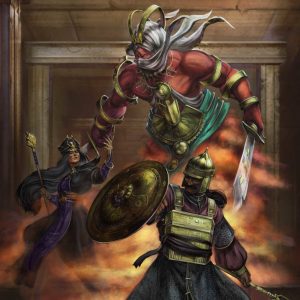
People believe that there is a very simple reason why two of the three greatest powers of Galania are located so close to the borders of the province: their lands were cut in half by Imperial decree. Using the river Sinia as a convenient border, Charles II recognized in the families of Saon and Lerac two potential rivals to the heirs of Armatellum. That is, at any rate, what the heirs to those families — at least those who survived — would claim to this day. The reality, however, was more complex.
There are at least two different reasons for the founding of this new province. The first was political: the southern Galtonni settlements had been literally conquered by Charles and his son, thus providing solid ground for them to include “King of Galans” to the Emperor’s Titles, by right of conquest. But the term “Galans” was not a clearly defined one and was often associated with the old Galtonni settlements, which, in turn, included almost half of today’s Galania-Trans-Sinia. To claim that such a huge expanse could be brought under a single royal crown would only alarm the rest of the nobility and shake the fledgling Empire to its core in its conception. By containing the sovereignty to a much more limited space — and one ruled by ready contenders to the Imperial Throne no less — Perrin disarmed them in a way that could be accepted by the rest of his vassals not simply as a proper claim, but as a shrewd political move as well.
The second reason was cultural. Unlike the Heartland settlements of Galania that had largely maintained their old Galtonni character and roots, the kingdoms beyond the Sinia had been founded by a mixture of peoples that, through the centuries, had begun to differentiate from their Heartland cousins. A combination of Hermanni, Galtonni and other tribes, such as the Tefts, the Berawe and the Pekhts, had settled these lands in equal measure, giving rise to a new culture that, while resembling others, was becoming clearly distinct, as was the dialect they were using. Many early Nord raiders had been assimilated by their population to this mix and, while their numbers were nowhere near those that Norvden would come to house, they were not few.
The true and most important reason for the forging of this new province, however, was financial. In the aftermath of Svarthgalm’s invasion, the north lay in shambles. Economies had been shattered; Nord raiders and monsters, stranded by the departure of their fleets, still roamed the lands, plaguing the roads as highwaymen and the villages as robbers. What’s more, the “scorched earth” tactic employed in the north by earl Rafalic to cut off the Nords from their ships and supplies ensured that the invasion army would leave nothing standing. Farmsteads were left without animals, grain houses emptied and gardens and crops subsumed and trampled. At the same time, an immense number of capable hands died in this prolonged war, while major castles and towns were barely left standing by the fires of the raiders. In short, much as the nobility of Galania would froth and rage about political ploys by the Emperors — and, to a certain degree, be right in their anger — the reality was that the needs of the lands across the Sinia were entirely different from those of the Heartlands. Forging a province that would dedicate itself to the restructure of an economy from the ground up made perfect administrative sense. The fact that the Sinia provided a convenient border was simply a very well exploited circumstance.
These dismal financial origins would leave the province gimped for centuries, despite the efforts of the Emperors. In fact, throughout history it became a point of friendly competition among the Emperors to display their work in Galania-Trans-Sinia. Perrin would found the Temple of the Aspects in Vercy. While the Temple never acted as the center Theist cathedrals had become and eventually fell out of use, it did work as an attempt to lure working hands to the province, without, however, angering the Theists by founding a Deist cathedral in a rich city. Charles-Louis would found the Academia Naturalis in Burneux, the lead institution for the study of agriculture to this day, as well as the University of Pravia, now specializing in law studies and rhetoric. Otto I would turn the abandoned castle of Jugh into the lesser Chapter of the Quiet Water, far to the north among the swamped shores of the province. In his vanity, however, no one portrayed this competition more than Ludwig (or Louis) the Beautiful; he single-handedly transformed Vercy into the Garden City, turning the Temple of the Aspects into his personal summer estate, while using an extraordinary amount of funds to transfer and then magically sustain an immense conservatory, the largest greenhouse garden in the world, containing endless flower and plant species from around the world. This would drag the southern parts of the province into more refined company; but just as Vercy itself hides the decadent presence of the slums in its midst, so does its evolution hide the darker corners of the province.
Despite the efforts of Emperors, the reality remained through history that Galania-Trans-Sinia would always be limping behind the rest of the Kingdoms in terms of financial power. While they struggled to rebuild, other provinces built roads, established stations and ensured that those would be preferred for the transfer of goods. At the same time, their merchants would establish connections throughout the continent, which they, along with their rulers, would prove loath to relinquish. Lerac, Saon and later Leona, Broslaw, Engart and even the distant Velonest would outmaneuver the Sinians on every turn, effectively dominating the tariff laws over the province’s own trade routes. When the province was ready to accommodate large ports and secure the transfer of goods, the largest trade houses had already established an elaborate network which was viciously protected by the Conclave. This left the province with an excellent opportunity, however: smuggling. Spending decades, if not centuries, in a poor financial state, the province had traditionally been plagued by bandits and outlaws. Today, the “diplomatic missions” that move in and out of Vercy at all times provide the perfect cover for enterprises that wish to avoid the usual routes and tariffs, thus finding a very accommodating alternative in the large province of Galania-Trans-Sinia. While much more limited in scope than popular trade routes, the practice had its merits; the many bandits and highwaymen of the province soon found a new occupation and a solid base of understanding with the local sovereigns.
So it was that Galania-Trans-Sinia, despite both its size and its location, was ignored by the trade alliances that were forged and in fact found extreme resistance at every corner; and thus, it was led to different methods for profit. In that sense, one could claim that it has never recovered from the Nord Invasion, despite the centuries that have passed since then and it is no coincidence that in such an expansive province only two major cities have risen, both of which were supported and funded by different Emperors. That, however, is not to say that the province remains poor or lawless. Far from it. Galania-Trans-Sinia is nothing but organized, self-sustained and what it lacks in large cities it makes up for in almost three dozen castle-kingdoms — the most in any province. And each of those is heavily militarized and, perhaps most importantly, many of them house Order Priories.
Forgotten or ignored by the tumultuous political and financial games of the rest of the Kingdoms with the exception of Vercy, the Kings of the province had always retained an exemplary relationship with the Orders. In part, this is because of the Sword’s sacrifice during the invasion; it has never been forgotten and, in fact, tradition dictates that Sword Brothers are always offered roof and shelter if so asked. But traditions aside, while right in the center of the Kingdoms, the Order Priories of Galania-Trans-Sinia avoid the attention they would draw in the Heartlands or the more politically active kingdoms, enjoying a much more tolerant environment than those offered where the nobility is less inclined to accept their interventions.
In return, the Orders have always assisted the local rulers, turning a blind eye to the less than savory enterprises of some. If the Orders of old had no issue with elevating brigand leaders to the position of Kings, then certainly today’s would not object to the little… side-projects of the established ones. What the Orders did ensure, however, was that the local population would not suffer from the outlaws, and today some of the best trained militia forces in the Kingdoms can be found in the province. In time, the military experience of generations would become compact and small military schools would be formed. This eventually provided the foundation for the best and only major export of the province — Men-at-Arms. Rivaling even their province of origin, the Allerian Plains, Sinian professional soldiers are praised for their training and professionalism and can be found throughout the Kingdoms.












